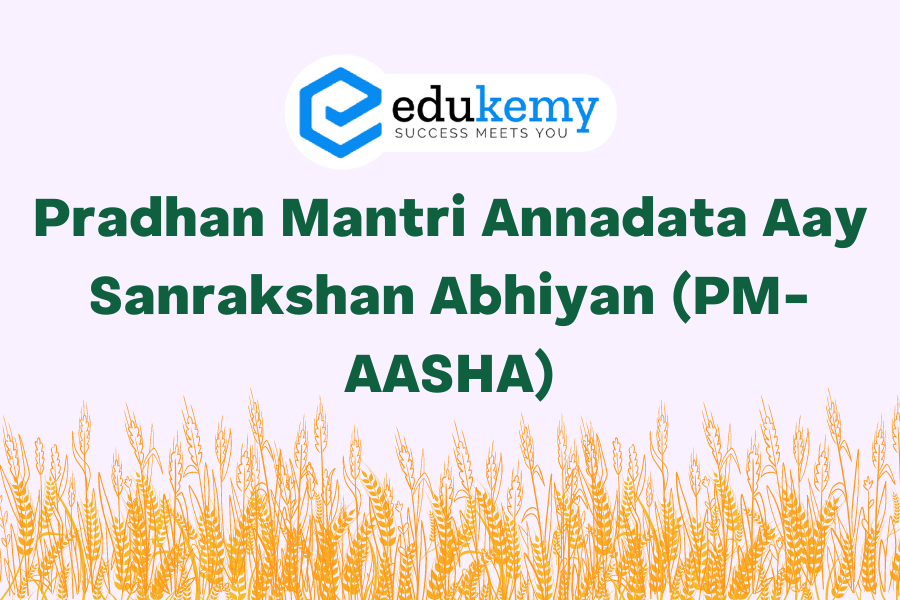
PM-AASHA is a scheme initiated by the Government of India aimed at rationalizing agricultural produce pricing and policies. The primary objectives of the scheme include enhancing efficiency, reducing wastages and leakages in storage, and achieving fiscal gains. The scheme is structured with three main components:
- Price Support Scheme (PSS):
- Under PSS, the government engages in the physical procurement of agricultural produce. This involves the direct purchase of commodities such as paddy, wheat, and nutri-cereals/coarse grains from farmers. The government sets a Minimum Support Price (MSP), and through PSS, it ensures that farmers receive remunerative prices for their produce.
- Price Deficiency Payment Scheme (PDPS):
- PDPS operates differently from PSS. Instead of physical procurement, PDPS provides a mechanism for making direct payments to farmers based on the difference between the MSP and the market price. In other words, if the market price falls below the MSP, the government compensates farmers for the shortfall. This approach helps in supporting farmers without the government having to physically procure the produce.
- Pilot of Private Procurement and Stockist Scheme:
- This component involves the participation of private entities in the procurement and stocking of agricultural produce. It is designed to encourage private sector involvement in supporting farmers and ensuring price stability.
The scheme addresses the challenges faced by farmers in getting fair prices for their crops, provides a safety net against price volatility, and contributes to overall agricultural sector development. By diversifying the methods of intervention, PM-AASHA aims to be more flexible and effective in ensuring farmers’ income security.
It’s worth noting that agricultural support schemes and policies may evolve, and it’s recommended to check the latest updates and official sources for the most current information on PM-AASHA.
Contents
- 1 FAQs
- 1.1 Q: What is Pradhan Mantri Annadata Aay Sanrakshan Abhiyan (PM-AASHA)?
- 1.2 Q: How does Price Support Scheme (PSS) under PM-AASHA work?
- 1.3 Q: What is the Price Deficiency Payment Scheme (PDPS) component of PM-AASHA?
- 1.4 Q: How does the Pilot of Private Procurement and Stockist Scheme (PPPS) benefit farmers under PM-AASHA?
- 1.5 Q: What are the primary objectives of PM-AASHA?
- 2 In case you still have your doubts, contact us on 9811333901.
FAQs
Q: What is Pradhan Mantri Annadata Aay Sanrakshan Abhiyan (PM-AASHA)?
Pradhan Mantri Annadata Aay Sanrakshan Abhiyan (PM-AASHA) is a government initiative aimed at ensuring remunerative prices to farmers for their produce. It encompasses three key schemes: Price Support Scheme (PSS), Price Deficiency Payment Scheme (PDPS), and Pilot of Private Procurement and Stockist Scheme (PPPS).
Q: How does Price Support Scheme (PSS) under PM-AASHA work?
Under PSS, the government assures procurement of notified crops at Minimum Support Price (MSP) in case market prices fall below MSP. This ensures farmers receive a fair price for their produce, mitigating their income uncertainties.
Q: What is the Price Deficiency Payment Scheme (PDPS) component of PM-AASHA?
PDPS is an alternative to physical procurement where farmers are directly paid the difference between MSP and the selling/modal price of the commodity prevailing in the market. It operates via direct bank transfer to the farmers’ accounts, reducing market distortions and ensuring fair compensation.
Q: How does the Pilot of Private Procurement and Stockist Scheme (PPPS) benefit farmers under PM-AASHA?
PPPS allows private agencies to procure oilseeds and pulses at MSP in designated states. This diversifies procurement channels, enhances market efficiency, and provides farmers with additional avenues to sell their produce at fair prices, reducing dependency on government agencies.
Q: What are the primary objectives of PM-AASHA?
PM-AASHA aims to address the income uncertainties faced by farmers by ensuring remunerative prices for their produce, enhancing their income security. It seeks to strengthen the agricultural marketing infrastructure and promote private sector participation in procurement, ultimately contributing to the welfare of farmers and agricultural sustainability.
In case you still have your doubts, contact us on 9811333901.
For UPSC Prelims Resources, Click here
For Daily Updates and Study Material:
Join our Telegram Channel – Edukemy for IAS
- 1. Learn through Videos – here
- 2. Be Exam Ready by Practicing Daily MCQs – here
- 3. Daily Newsletter – Get all your Current Affairs Covered – here
- 4. Mains Answer Writing Practice – here

